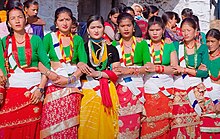खस (Nepali) | |
|---|---|
 Portrait of Khas women holding hands and performing Deuda | |
| Total population | |
| c. 15.3 million[1] | |
| Regions with significant populations | |
| Nepal, India, Bhutan | |
| Languages | |
| Nepali[2] | |
| Religion | |
| Hinduism | |
| Related ethnic groups | |
| Kumaoni, Garhwali, Pahari and other Indo-Aryans |

Khas peoples or Khas Tribes, (English: /kɑːs/; Nepali: खस) popularly known as Khashya[nb 1] are an Indo-Aryan ethno-linguistic group native to the Himalayan region of the Indian subcontinent, in what is now the South Asian country of Nepal, as well as the Indian states of Uttarakhand, Himachal Pradesh, West Bengal, Assam and Sikkim.[nb 2] Khas consists of many subtribes like Kshetri, Thakuri, Bahun, khas dalit and Sanyasis and all spread across the Himalayas.[3][4][5][6][7][8][9][10][11][12][17]
Historically, Khas were the speakers of an ancient Khas language from the Indo-Aryan language family[2][18] and the earliest recorded speakers of the Western Pahari languages.[14] The large portion of the Indo-Aryan speakers throughout lower Himalayas were the Masto people.[19] An intrusion of this tribe from the Western and Northwestern Himalayas into Central Himalayas is substantiated by the early linguistic evidences related to the Nepali language.[18] They were also known as Parbatiyas/Parbates and are currently known as Paharis/Pahadis. (literally, "from the hills"). They were also referred to as Yartse in Tibet and are also known as Khasan by Bhotia people. The term Khas has now become obsolete, as the Khas people have adopted communal identities because of the negative stereotypes associated with the term Khas. In Nepal the native speaker of Nepali language are known as Khas people.[20][21][22]
According to the Constitution of Nepal, BahunNepali Dalit, Kshetris, Thakuris, and Sanyasis (Dashnami) who are citizens of Nepal should be considered as "Khas Arya" for electoral purposes.[13]
- ^ "Nepali (npi)". Ethnologue. Retrieved 2016-10-06.
- ^ a b Richard Burghart 1984, pp. 118–119.
- ^ a b Khadka, Suman (25 February 2015). "Drawing caste lines". The Kathmandu Post.
- ^ a b "Khas Arya quota provision in civil services opposed". thehimalayantimes.com. 10 November 2017. Retrieved 2018-05-01.
- ^ a b "Nepal's election may at last bring stability". The Economist. Retrieved 2018-05-01.
- ^ a b "PM briefs international community". The Kathmandu Post. Retrieved 2018-04-06.
- ^ a b "Quotable quota". Nepali Times. Retrieved 2018-05-01.
- ^ a b "Next Door Nepal: Another chink in the wall". indianexpress.com. 2 April 2018. Retrieved 2018-05-01.
- ^ a b "Oli in balancing avatar". myrepublica.com. Retrieved 2018-05-01.
- ^ a b "Nepal seeks unity from its first local elections in 20 years". Nikkei Asian Review. Retrieved 2018-05-01.
- ^ a b "Lessons for India From Nepal's History of Banning Cow Slaughter". The Wire. Retrieved 2018-05-01.
- ^ a b "What does high caste chauvinism look like?". The Kathmandu Post. 7 April 2018. Retrieved 2018-05-01.
- ^ a b "Part-8 Federal Legislature". Nepal Law Commission. Archived from the original on 2021-04-28. Retrieved 2019-08-05.
- ^ a b Saksena 2019, p. 109.
- ^ Stein 1989, p. 433.
- ^ Stein 1989, p. 434.
- ^ Hagen & Thapa 1998, p. 114.
- ^ a b Jain & Cardona 2007, p. 543.
- ^ Saklani 1998, p. 71.
- ^ William Brook Northey & C. J. Morris 1928, p. 123.
- ^ K. S. Singh 2005, p. 851.
- ^ Dor Bahadur Bista 1991, p. 48.
Cite error: There are <ref group=nb> tags on this page, but the references will not show without a {{reflist|group=nb}} template (see the help page).